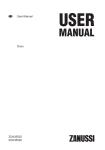Download Zanussi ZOA35525WK
Transcript
EN User manual Oven ZOA35525 ZOA35526 Contents Safety information _ _ _ _ _ _ _ _ _ _ _ _ _ _ Safety instructions _ _ _ _ _ _ _ _ _ _ _ _ _ _ Product description _ _ _ _ _ _ _ _ _ _ _ _ _ Before first use _ _ _ _ _ _ _ _ _ _ _ _ _ _ _ _ Daily use _ _ _ _ _ _ _ _ _ _ _ _ _ _ _ _ _ _ _ Clock functions _ _ _ _ _ _ _ _ _ _ _ _ _ _ _ _ Using the accessories _ _ _ _ _ _ _ _ _ _ _ _ 2 3 5 5 6 7 8 Additional functions _ _ _ _ _ _ _ _ _ _ _ _ _ 8 Helpful hints and tips _ _ _ _ _ _ _ _ _ _ _ _ _ 9 Care and cleaning _ _ _ _ _ _ _ _ _ _ _ _ _ 14 What to do if… _ _ _ _ _ _ _ _ _ _ _ _ _ _ _ 16 Installation _ _ _ _ _ _ _ _ _ _ _ _ _ _ _ _ _ _ 17 Environment concerns _ _ _ _ _ _ _ _ _ _ _ 19 Subject to change without notice. Safety information Before the installation and use of the appliance, carefully read the supplied instructions. The manufacturer is not responsible if an incorrect installation and use causes injuries and damages. Always keep the instructions with the appliance for future reference. Children and vulnerable people safety Warning! Risk of suffocation, injury or permanent disability. • This appliance can be used by children aged from 8 years and above and persons with reduced physical, sensory or mental capabilities or lack of experience and knowledge if they are supervised by an adult or a person who is responsible for their safety. • Do not let children play with the appliance. • Keep all packaging away from children. • Keep children and pets away from the appliance when it operates or when it cools down. Accessible parts are hot. • If the appliance has a child safety device, we recommend that you activate it. • Cleaning and user maintenance shall not be made by children without supervision. General Safety • Internally the appliance becomes hot when in operation. Do not touch the heating elements that are in the appliance. Always use oven gloves to remove or put in accessories or ovenware. 2 www.zanussi.com • Do not use a steam cleaner to clean the appliance. • Before maintenance cut the power supply. • Do not use harsh abrasive cleaners or sharp metal scrapers to clean the glass door since they can scratch the surface, which may result in shattering of the glass. • To remove the shelf supports first pull the front of the shelf support and then the rear end away from the side walls. Install the shelf supports in the opposite sequence. Safety instructions Installation Warning! Only a qualified person must install this appliance. • Remove all the packaging. • Do not install or use a damaged appliance. • Obey the installation instruction supplied with the appliance. • Always be careful when you move the appliance because it is heavy. Always wear safety gloves. • Do not pull the appliance by the handle. • Keep the minimum distance from the other appliances and units. • Make sure that the appliance is installed below and adjacent safe structures. • The sides of the appliance must stay adjacent to appliances or to units with the same height. Electrical connection Warning! Risk of fire and electrical shock. • All electrical connections should be made by a qualified electrician. • The appliance must be earthed. • Make sure that the electrical information on the rating plate agrees with the power supply. If not, contact an electrician. • Always use a correctly installed shockproof socket. www.zanussi.com • Do not use multi-plug adapters and extension cables. • Make sure not to cause damage to the mains plug and to the mains cable. Contact the Service or an electrician to change a damaged mains cable. • Do not let mains cables to come in touch with the appliance door, specially when the door is hot. • The shock protection of live and insulated parts must be fastened in such a way that it cannot be removed without tools. • Connect the mains plug to the mains socket only at the end of the installation. Make sure that there is access to the mains plug after the installation. • If the mains socket is loose, do not connect the mains plug. • Do not pull the mains cable to disconnect the appliance. Always pull the mains plug. • Use only correct isolation devices: line protecting cut-outs, fuses (screw type fuses removed from the holder), earth leakage trips and contactors. • The electrical installation must have an isolation device which lets you disconnect the appliance from the mains at all poles. The isolation device must have a contact opening width of minimum 3 mm. Use 3 Warning! Risk of injury, burns or electric shock or explosion. • Use this appliance in a household environment. • Do not change the specification of this appliance. • Make sure that the ventilation openings are not blocked. • Do not let the appliance stay unattended during operation. • Deactivate the appliance after each use. • Internally the appliance becomes hot when in operation. Do not touch the heating elements that are in the appliance. Always use oven gloves to remove or put in accessories or ovenware. • Be careful, when you open the appliance door while the appliance is in operation. Hot air can release. • Do not operate the appliance with wet hands or when it has contact with water. • Do not apply pressure on the open door. • Do not use the appliance as a work surface or as a storage surface. • Always keep the appliance door closed when the appliance is in operation. • Open the appliance door carefully. The use of ingredients with alcohol can cause a mixture of alcohol and air. • Do not let sparks or open flames to come in contact with the appliance when you open the door. • Do not put flammable products or items that are wet with flammable products in, near or on the appliance. Warning! Risk of damage to the appliance. • To prevent damage or discoloration to the enamel: – Do not put ovenware or other objects in the appliance directly on the bottom. – Do not put aluminium foil directly on the bottom of the appliance. – do not put water directly into the hot appliance. 4 – do not keep moist dishes and food in the appliance after you finish the cooking. – be careful when you remove or install the accessories. • Discoloration of the enamel has no effect on the performance of the appliance. It is not a defect in the sense of the warranty law. • Use a deep pan for moist cakes. Fruit juices cause stains that can be permanent. Care and Cleaning Warning! Risk of injury, fire or damage to the appliance. • Before maintenance, deactivate the appliance and disconnect the mains plug from the mains socket. • Make sure the appliance is cold. There is the risk that the glass panels can break. • Replace immediately the door glass panels when they are damaged. Contact the Service. • Be careful when you remove the door from the appliance. The door is heavy! • Clean regularly the appliance to prevent the deterioration of the surface material. • Remaining fat or food in the appliance can cause fire. • Clean the appliance with a moist soft cloth. Only use neutral detergents. Do not use abrasive products, abrasive cleaning pads, solvents or metal objects. • If you use an oven spray, obey the safety instructions on the packaging. • Do not clean the catalytic enamel (if applicable) with any kind of detergent. Internal light • The type of light bulb or halogen lamp used for this appliance, is only for household appliances. Do not use it for house lighting. Warning! Risk of electrical shock. • Before replacing the lamp, disconnect the appliance from the power supply. • Only use lamps with the same specifications. Disposal www.zanussi.com Warning! Risk of injury or suffocation. • Disconnect the appliance from the mains supply. • Cut off the mains cable and discard it. • Remove the door catch to prevent children and pets to get closed in the appliance. Product description 1 2 3 4 6 Grill 7 Oven lamp 5 6 5 7 4 11 3 8 2 1 10 9 1 Knob for the oven functions 2 Power indicator 3 Electronic programmer 4 Knob for the temperature 5 Temperature indicator 8 Fan 9 Shelf support, removable 10 Rating plate 11 Shelf positions Oven accessories • Wire shelf For cookware, cake tins, roasts. • Grill- / Roasting pan To bake and roast or as pan to collect fat. • Trivet For roasting and grilling. Use the trivet only with the Grill- / roasting pan. • Telescopic runners For shelves and trays. Before first use Warning! Refer to "Safety information" chapter. Initial cleaning • Remove all accessories and removable shelf supports (if applicable). • Clean the appliance before first use. Important! Refer to the chapter "Care and cleaning". Setting the time You must set the time before you operate the oven. When you connect the appliance to the electrical supply or after a power cut, the indicator for the Time of Day function flashes. Press the + or - button to set the correct time. www.zanussi.com After approximately five seconds, the flashing stops and the display shows the time of day you set. To change the time, press again and again until the indicator for the Time of Day function flashes. You must not set the Duration or End function at the same time. 5 Preheating Preheat the empty appliance to burn off the remaining grease. 1. Set the function and the maximum temperature. 2. Let the appliance operate for 45 minutes. 3. Set the function and the maximum temperature. 4. Let the appliance operate for 15 minutes. Accessories can become hotter than usually. The appliance can emit an odour and smoke. This is normal. Make sure that the airflow is sufficient. Daily use Warning! Refer to "Safety information" chapter. Activating and deactivating the appliance 1. Turn the knob for the oven functions to an oven function. The power indicator comes on while the appliance operates. 2. 3. Turn the knob for the temperature to a temperature. The temperature indicator comes on while the temperature in the appliance increases. To deactivate the appliance, turn the knob for the oven functions and the knob for the temperature to the Off position. Oven functions Oven function 6 Application Off position The appliance is off. Light To activate the oven lamp without a cooking function. Grilling To grill flat food items in small quantities in the middle of the shelf. To make toast. Fast Grilling To grill flat food items in large quantities. To make toast. The full grill element operates. Turbo Grilling To cook large pieces of meat. The grill element and the oven fan operate one after the other and circulate hot air around the food. True Fan Cooking To roast or roast and bake food with the same cooking temperature, on more than one shelf, without flavour transference. Defrost To thaw frozen food. The knob for the temperature must be in the off position. www.zanussi.com Clock functions Electronic programmer 1 2 1 1 Function indicators 2 Time display 3 Button + 4 Selection button 5 Button - 5 4 3 Clock function Time of day Minute Minder Duration End Application To set, change or check the time of day. To set a countdown time. This function has no effect on the operation of the oven. To set how long the appliance must operate. To set when the appliance must be deactivated. You can use Duration and End at the same time to set the time when the appliance must be activated and then deactivated. , then End . First set Duration Setting the clock functions 1. For Duration and End , set an oven function and temperature. This is not nec. essary for the Minute Minder 2. Press the Selection button again and again until the indicator for the necessary clock function flashes. 3. Press + or - to set the time for the necessary clock function. The display shows the indicator for the clock function you set. When the set time ends, the indicator flashes and an acoustic signal sounds for two minutes. With the Duration and End functions, the appliance deactivates automatically. www.zanussi.com 7 4. 5. Press a button to stop the signal. Turn the knob for the oven functions and the knob for the temperature to the off position. 2. Press and hold the button -. The clock function goes out after some seconds. Cancelling the clock functions 1. Press the Selection button again and again until the necessary function indicator flashes. Using the accessories Warning! Refer to "Safety information" chapter. Telescopic runners Trivet and Grill- / Roasting pan Important! Keep the installation instructions for the telescopic runners for future use. With telescopic runners you can put in and remove the shelves more easily. °C °C 1 Pull out the right and left hand telescopic runners. Caution! Do not clean the telescopic runners in the dishwasher. Do not lubricate the telescopic runners. 2 Put the wire shelf on the telescopic runners and carefully push them into the appliance. Make sure you push back the telescopic runners fully in the appliance before you close the oven door. Warning! Be careful when you remove the accessories from a hot appliance. There is a risk of burns. To roast larger pieces To grill flat food items of meat or poultry on in large quantities one level: and to make toast: Put the trivet in the grill- / roasting pan so that the supports point up. Put the trivet in the grill- / roasting pan so that the supports point down. Put the grill- / roasting pan in the oven at the necessary level. Additional functions Cooling fan When the appliance operates, the cooling fan activates automatically to keep the surfaces of the appliance cool. If you deactivate the appliance, the cooling fan continues to operate until the temperature in the appliance cools down. 8 Safety thermostat Incorrect operation of the appliance or defective components can cause dangerous overheating. To prevent this, the oven has a safety thermostat which interrupts the power supply. The oven activates again automatically when the temperature drops. www.zanussi.com Helpful hints and tips • The appliance has five shelf levels. Count the shelf levels from the bottom of the appliance floor. • The appliance has a special system which circulates the air and constantly recycles the steam. With this system you can cook in a steamy environment and keep the food soft inside and crusty outside. It decreases the cooking time and energy consumption to a minimum. • Moisture can condense in the appliance or on the door glass panels. This is normal. Always stand back from the appliance when you open the appliance door while cooking. To decrease the condensation, operate the appliance for 10 minutes before cooking. • Clean the moisture after each use of the appliance. • Do not put the objects directly on the appliance floor and do not put aluminium foil on the components when you cook. This can change the baking results and cause damage to the enamel. • If you use two baking trays at the same time, keep one empty level between them. Cooking meat and fish • Use a deep pan for very fatty food to prevent the oven from stains that can be permanent. • Leave the meat for approximately 15 minutes before carving so that the juice does not seep out. • To prevent too much smoke in the oven during roasting, add some water into the deep pan. To prevent the smoke condensation, add water each time after it dries up. Cooking times Cooking times depend on the type of food, its consistency, and volume. Initially, monitor the performance when you cook. Find the best settings (heat setting, cooking time, etc.) for your cookware, recipes and quantities when you use this appliance. Baking cakes • Do not open the oven door before 3/4 of the set cooking time is up. Baking and roasting table CAKES True Fan Cooking Shelf position Temp [°C] Cooking time [min] Notes Whisked recipes 3 (1 and 4) 160 45 - 60 In a cake mould Shortbread dough 3 (1 and 4) 160 20 - 30 In a cake mould Buttermilk cheesecake 2 165 60 - 80 In a 26 cm cake mould Apple cake (Apple pie) 1 (left and right) 160 80 - 100 In two 20 cm cake moulds on a wire shelf1) Strudel 2 150 60 - 80 In a baking tray Jam-tart 2 (left and right) 165 30 - 40 In a 26 cm cake mould 2 160 50 - 60 In a 26 cm cake mould TYPE OF DISH Sponge cake www.zanussi.com 9 True Fan Cooking TYPE OF DISH Shelf position Temp [°C] Cooking time [min] Notes Christmas cake / Rich fruit cake 2 150 90 - 120 In a 20 cm cake mould1) Plum cake 2 160 50 - 60 In a bread tin1) Small cakes - one level 3 150 - 160 20 - 30 In a baking tray Small cakes - two levels 2 and 4 150 - 160 25 - 35 In a baking tray 1, 3 and 5 150 - 160 30 - 45 In a baking tray Biscuits / pastry stripes - one level 3 140 - 150 30 - 35 In a baking tray Biscuits / pastry stripes - two levels 2 and 4 140 - 150 35 - 40 In a baking tray Biscuits / pastry stripes - three levels 1, 3 and 5 140 - 150 35 - 45 In a baking tray Meringues - one level 3 120 80 - 100 In a baking tray Meringues- two levels 2 and 4 120 80 - 100 In a baking tray1) 3 190 12 - 20 In a baking tray1) Eclairs - one level 3 170 25 - 35 In a baking tray Eclairs - two levels 2 and 4 170 35 - 45 In a baking tray Plate tarts 2 170 45 - 70 In a 20 cm cake mould Rich fruit cake 2 150 110 - 120 In a 24 cm cake mould 2 (left and right) 160 50 - 60 In a 20 cm cake mould Small cakes - three levels Buns Victoria sandwich 1) Preheat for 10 minutes. BREAD AND PIZZA True Fan Cooking Shelf position Temp [°C] Cooking time [min] Notes 1 190 60 - 70 1 - 2 pieces, 500 gr per piece1) Rye bread 1 180 30 - 45 In a bread tin Bread rolls 2 (2 and 4) 180 25 - 40 6 - 8 rolls in a baking tray1) Pizza 1 200 - 210 10 - 20 In a baking tray or a deep pan1) Scones 3 190 10 - 20 In a baking tray1) TYPE OF DISH White bread 1) Preheat for 10 minutes. FLANS 10 www.zanussi.com True Fan Cooking Shelf position Temp [°C] Cooking time [min] Notes Pasta flan 2 180 40 - 50 In a mould Vegetable flan 2 175 45 - 60 In a mould Quiches 1 180 50 - 60 In a mould1) Lasagne 2 180 - 190 25 - 40 In a mould1) Cannelloni 2 180 - 190 25 - 40 In a mould1) TYPE OF DISH 1) Preheat for 10 minutes. MEAT True Fan Cooking Shelf position Temp [°C] Cooking time [min] Notes Beef 2 190 50 - 70 On a wire shelf Pork 2 180 90 - 120 On a wire shelf Veal 2 175 90 - 120 On a wire shelf English roast beef, rare 2 200 50 - 60 On a wire shelf English roast beef, medium 2 200 60 - 70 On a wire shelf English roast beef, well done 2 200 70 - 75 On a wire shelf Shoulder of pork 2 170 120 - 150 With rind Shin of pork 2 160 100 - 120 2 pieces Lamb 2 175 110 - 130 Leg Chicken 2 200 70 - 85 Whole Turkey 2 160 210 - 240 Whole Duck 2 220 120 - 150 Whole Goose 1 160 150 - 200 Whole Rabbit 2 175 60 - 80 Cut in pieces Hare 2 175 150 - 200 Cut in pieces Pheasant 2 175 90 - 120 Whole Notes TYPE OF DISH FISH True Fan Cooking Shelf position Temp [°C] Cooking time [min] Trout / Sea bream 2 175 40 - 55 3 - 4 fish Tuna fish / Salmon 2 175 35 - 60 4 - 6 fillets TYPE OF DISH www.zanussi.com 11 Grilling Preheat the empty oven for 10 minutes, before cooking. Quantity TYPE OF DISH Grilling Cooking time [min] Pieces [g] Shelf position Temp [°C] 1st side 2nd side Fillet steaks 4 800 4 max. 12 - 15 12 - 14 Beef steaks 4 600 4 max. 10 - 12 6-8 Sausages 8 - 4 max. 12 - 15 10 - 12 Pork chops 4 600 4 max. 12 - 16 12 - 14 Chicken (cut in 2) 2 1000 4 max. 30 - 35 25 - 30 Kebabs 4 - 4 max. 10 - 15 10 - 12 Breast of chicken 4 400 4 max. 12 - 15 12 - 14 Hamburger 6 600 4 max. 20 - 30 - Fish fillet 4 400 4 max. 12 - 14 10 - 12 Toasted sandwiches 4-6 - 4 max. 5-7 - Toast 4-6 - 4 max. 2-4 2-3 Turbo Grilling Beef TYPE OF DISH Quantity Shelf position Temperature [°C] Time [min] Roast beef or fillet, rare per cm of thickness 1 190 - 200 1) 5-6 Roast beef or fillet, medium per cm of thickness 1 180 - 190 1) 6-8 Roast beef or fillet, well done per cm of thickness 1 170 - 180 1) 8 - 10 TYPE OF DISH Quantity Shelf position Temperature [°C] Time [min] Shoulder, neck, ham joint 1 - 1.5 kg 1 160 - 180 90 - 120 1) Preheat the oven. Pork Chop, spare rib 1 - 1.5 kg 1 170 - 180 60 - 90 Meat loaf 750 g - 1 kg 1 160 - 170 50 - 60 Pork knuckle (precooked) 750 g - 1 kg 1 150 - 170 90 - 120 Veal 12 www.zanussi.com TYPE OF DISH Quantity Shelf position Temperature [°C] Roast veal Knuckle of veal Time [min] 1 kg 1 160 - 180 90 - 120 1.5 - 2 kg 1 160 - 180 120 - 150 Lamb TYPE OF DISH Quantity Shelf position Temperature [°C] Time [min] Leg of lamb, roast lamb 1 - 1.5 kg 1 150 - 170 100 - 120 Saddle of lamb 1 - 1.5 kg 1 160 - 180 40 - 60 Poultry Quantity Shelf position Temperature [°C] Time [min] Poultry portions TYPE OF DISH 200 - 250 g each 1 200 - 220 30 - 50 Chicken , half 35 - 50 400 - 500 g each 1 190 - 210 Chicken, poulard 1 - 1.5 kg 1 190 - 210 50 - 70 Duck 1.5 - 2 kg 1 180 - 200 80 - 100 Goose 3.5 - 5 kg 1 160 - 180 120 - 180 Turkey 2.5 - 3.5 kg 1 160 - 180 120 - 150 Turkey 4 - 6 kg 1 140 - 160 150 - 240 Quantity Shelf position Temperature [°C] Time [min] 1 - 1.5 kg 1 210 - 220 40 - 60 Fish (steamed) TYPE OF DISH Whole fish Defrosting TYPE OF DISH [g] Defrosting time [min] Further defrosting time [min] Notes Chicken 1000 100 - 140 20 - 30 Place the chicken on an upturned saucer placed on a large plate. Turn halfway through. Meat 1000 100 - 140 20 - 30 Turn halfway through. Meat 500 90 - 120 20 - 30 Turn halfway through. Trout 150 25 - 35 10 - 15 - Strawberries 300 30 - 40 10 - 20 - Butter 250 30 - 40 10 - 15 - Cream 2 x 200 80 - 100 10 - 15 Cream can also be whipped when still slightly frozen in places. Gateau 1400 60 60 - www.zanussi.com 13 Drying - True Fan Cooking Cover the oven shelves with baking parchment. VEGETABLES TYPE OF DISH Shelf position Temperature [°C] Time [hr] 1/4 60 - 70 6-8 3 1/4 60 - 70 5-6 3 1/4 60 - 70 5-6 Mushrooms 3 1/4 50 - 60 6-8 Herbs 3 1/4 40 - 50 2-3 Temperature [°C] Time [hr] 1 level 2 levels Beans 3 Peppers Vegetables for soup FRUIT TYPE OF DISH Shelf position 1 level 2 levels Plums 3 1/4 60 - 70 8 - 10 Apricots 3 1/4 60 - 70 8 - 10 Apple slices 3 1/4 60 - 70 6-8 Pears 3 1/4 60 - 70 6-9 Information on acrylamides Important! According to the newest scientific knowledge, if you brown food (specially the one which contains starch), acrylamides can pose a health risk. Thus, we recommend that you cook at the lowest temperatures and do not brown food too much. Care and cleaning Warning! Refer to "Safety information" chapter. • Clean the front of the appliance with a soft cloth with warm water and a cleaning agent. • To clean metal surfaces use a usual cleaning agent. • Clean the oven interior after each use. Then you can remove dirt more easily and it does not burn on. • Clean stubborn dirt with a special oven cleaner. • Clean all oven accessories after each use and let them dry. Use a soft cloth with warm water and a cleaning agent. 14 • If you have nonstick accessories, do not clean them using aggressive agents, sharpedged objects or a dishwasher. It can destroy nonstick coating. Stainless steel or aluminium appliances: Clean the oven door with a wet sponge only. Dry it with a soft cloth. Do not use steel wool, acids or abrasive materials, as they can cause damage to the oven surface. Clean the oven control panel with the same precautions. Cleaning the door gasket • Regularly do a check of the door gasket. The door gasket is around the frame of the oven www.zanussi.com cavity. Do not use the appliance if the door gasket is damaged. Contact the Service Centre. • To clean the door gasket, refer to the general information about cleaning. Removable shelf supports and catalytic panels To clean the oven, remove the shelf supports and catalytic panels. Warning! Be careful when you remove the shelf supports. The catalytic panels are not attached to the oven walls and can fall out when you remove the shelf supports. Warning! Before maintenance, make sure that the appliance is cool. There is a risk of burns. 2 1 To support the self-cleaning process: 1. Activate the oven lamp. 2. Remove the accessories from the appliance. 3. Clean the oven floor with warm water and washing-up liquid, then dry it. 4. Set the function and maximum temperature. 5. Let the empty appliance operate for one hour. 6. When the appliance is cool, clean it with a soft and moist sponge. Warning! Do not clean the catalytic surface with oven sprays, abrasive cleaning agents, soap or other cleaning agents. There is a risk of damage to the catalytic surface. Warning! Keep children away when you clean the oven at a high temperature. The oven surface becomes very hot and there is a risk of burns. Discolouration of the catalytic surface has no effect on the catalytic properties. 1 Pull the front of the shelf support away from the side wall. Hold the rear end of the shelf support and the catalytic panel in position with the other hand. 2 Pull the rear end of the shelf support away from the side wall and remove it. Installing the shelf supports Install the shelf supports in the opposite sequence. The rounded ends of the shelf supports must point to the front. Catalytic walls The walls with catalytic enamel are self-cleaning. They absorb fat which collects on walls when the oven operates. www.zanussi.com Oven lamp Warning! Be careful when you change the oven lamp. There is a risk of electrical shock. Before you change the oven lamp: • Deactivate the oven. • Remove the fuses in the fuse box or deactivate the circuit breaker. Put a cloth on the bottom of the oven to prevent damage to the oven light and glass cover. Always hold the halogen lamp with a cloth to prevent grease residue from burning on the lamp. 1. 2. Turn the glass cover counterclockwise to remove it. Clean the glass cover. 15 3. 4. Replace the oven light bulb with an applicable 300 °C heat-resistant oven light bulb. Use the same oven lamp type. Install the glass cover. Cleaning the oven door The oven door has two panels of glass installed one behind the other. You can remove the oven door and the glass panel to clean them. Clean the door with a wet sponge and rub it dry with a soft cloth. Do not use steel wool, acids or abrasive cleaning agents because they can damage the surface. When the oven door is clean, install the glass panel in the opposite sequence. Make sure that you put the glass panel in the rubber distance holders. Caution! Do not use the appliance without the glass panel. The direction in which you open the glass depends on your oven model. You open the door from the right side in some models and from the left side in others. Removing the oven door and the glass panel A 1 Press the buttons at the sides of the door trim (A) on the upper cover and pull it upwards to remove it. B 2 Hold the inner glass (B) tightly with both hands and slide it upwards to remove it from its initial position. Caution! Make sure that you tightly hold glass B to prevent the glass from falling. What to do if… Warning! Refer to "Safety information" chapter. 16 www.zanussi.com Problem Possible cause Remedy The oven does not heat up. The appliance is deactivated. Activate the appliance. The oven does not heat up. The clock is not set. Set the clock. The oven does not heat up. The necessary settings are not set. Make sure that the settings are correct. The oven does not heat up. The fuse in the fuse box is released. Do a check of the fuse. If the fuse is released more than one time, contact a qualified electrician. The oven lamp does not operate. The oven lamp is defective. Replace the oven lamp. The display shows 12.00. There was a power cut. Set the clock. Steam and condensation settle on the food and in the oven. You left the dish in the oven for too long. Do not keep the dishes in the oven for longer than 15 - 20 minutes after the cooking ends. If you cannot find a solution to the problem yourself, contact your dealer or the service centre. The necessary data for the service centre is on the rating plate. The rating plate is on the front frame of the appliance cavity. We recommend that you write the data here: Model (MOD.) ......................................... Product number (PNC) ......................................... Serial number (S.N.) ......................................... Installation Warning! Refer to "Safety information" chapter. Building In 548 558 20 573 589 594 www.zanussi.com 17 in the frame and then tighten the four screws (B) supplied with the appliance. A B min. 550 20 580 min. 560 Electrical installation Important! Only a qualified person must do the electrical installation. 600 min. 550 20 The manufacturer is not responsible if you do not follow the safety precautions from the chapter "Safety information". min. 560 6 Securing the appliance to the cabinet 1. Open the appliance door. 2. Fasten the appliance to the cabinet. Put the four distance holders (A) into the holes This appliance is supplied without a main plug and a main cable. Applicable types of cables for Europe: • Minimum size Cable / flex: 1,5 mm² • Cable / flex type: H07 RN-F, H05 RN-F, H05 RRF, H05 VV-F, H05 V2V2-F (T90), H05 BB-F • Fuse 13 A Applicable types of cables for UK only Connection via Min. size Cable / flex Cable / flex type Fuse • 13 A socket outlet • 13 A spur box 2,5 mm² Three core butyl insulated 13 A min. Oven Control Circuit 2,5 mm² PVC / PVC twin and earth 15 A min. 20 A min. 18 www.zanussi.com Environment concerns The symbol on the product or on its packaging indicates that this product may not be treated as household waste. Instead it should be taken to the appropriate collection point for the recycling of electrical and electronic equipment. By ensuring this product is disposed of correctly, you will help prevent potential negative consequences for the environment and human health, which could otherwise be caused by inappropriate waste handling of this product. For more detailed www.zanussi.com information about recycling of this product, please contact your local council, your household waste disposal service or the shop where you purchased the product. Packaging material The packaging material is environmentallyfriendly and recyclable. Plastic parts are marked with international abbreviations such as PE, PS, etc. Dispose of the packaging material in the containers provided for this purpose at your local waste management facility. 19 397276101-B-282012 www.zanussi.com/shop
































